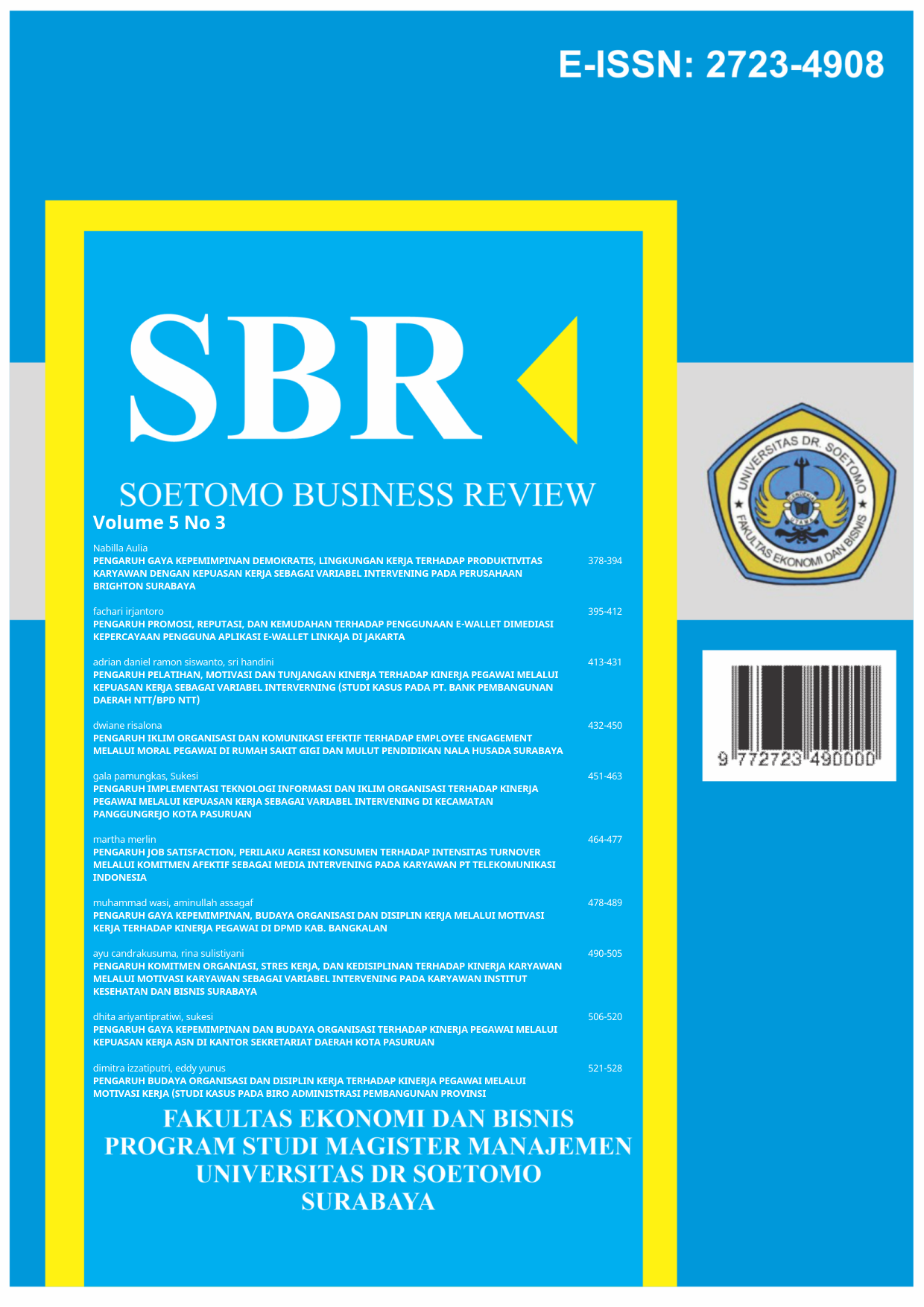PENGARUH IKLIM ORGANISASI DAN KOMUNIKASI EFEKTIF TERHADAP EMPLOYEE ENGAGEMENT MELALUI MORAL PEGAWAI DI RUMAH SAKIT GIGI DAN MULUT PENDIDIKAN NALA HUSADA SURABAYA
 Abstrak views: 46
,
Abstrak views: 46
,
 pdf (English) downloads: 48
pdf (English) downloads: 48
Abstrak
Perubahan dalam lingkungan kerja yang diakitbatkan oleh merebak dan berakhirnya pandemik COVID-19 memaksa manusia untuk berdapatasi dalam keterbatasan dan kembali pada kondisi normal baru. Perubahan cara dan lingkungan kerja pada akhirnya berdampak pada sikap kerja pegawai terhadap organisasi. Penelitian ini bertujuan untuk menganalisa pengaruh iklim organisasi dan komunikasi efektif terhadap employee engagement melaui moral pegawai di Rumah Sakit Gigi dan Mulut Pendidikan Nala Husada Surabaya. Jenis penelitian adalah penelitian eksplanatori dengan pendekatan metode kuantitatif. Metode pengumpulan datanya menggunakan kuisioner yang disebarkan pada 60 pegawai Rumah Sakit Gigi dan Mulut Pendidikan Nala Husada Surabaya. Teknik analisis data yang digunakan adalah analisis Structural Equation Modelling dengan menggunakan Partial Least Square. Hasil penelitian menunjukkan bahwa komunikasi efektif memiliki pengaruh secara langsung dan signifikan terhadap moral pegawai dan employee engagement. Moral pegwai juga memiliki pengaruh secara langsung yang signifikan terhadap employee engagement. Iklim organisasi dan komunikasi efektif memiliki pengaruh secara tidak langsung yang signifikan terhadap employee engagement. Penelitian ini menyarankan peningkatan employee engagement melalui peningkatan komunikasi efektif yang dipadukan dengan program-program yang dapat meningkatkan iklim organisasi serta moral pegawai di Rumah Sakit Gigi dan Mulut Pendidikan Nala Husada Surabaya.
Referensi
Anugwom, G.A. 2007. Issues, Principals Techniques and Practice in Administration and Management. Enugu: El’Denmark Publishers.
Astari, K., Kadiyono, A.L., Batubara, M. 2022. “Adaptasi Alat Ukur The Employee Engagement Scale (EES)”. Jurnal Ekonomi dan Bisnis, Vol. 11 no. 1 Juli 2022. (511-520)
Bailey, C., Madden, A., Alfes, K., dan Fletcher, L. 2017. “The Meaning, Antecedents and Outcomes of Employee Engagement: A Narrative Synthesis”. International Journal of Management Reviews, Vol 19. (31-53).
Bakker, A.B. 2017. “Strategic and Proactive Approaches to Work Engagement”. Organizational Dynamics, 46. (67-75)
Berberogly, A. 2018. “Impact of Organizational Climate on Organizational Commitment and Perceived Organizational Performance: Empirical Evidence from Public Hospitals. Berberoglu BMC Health Services Research (18:399).
Churcill, G.A., Ford, N.M., Walker, O.C. 1976. “Organizational Climate and Job Satisfaction in the Sales Force”. Journal of Marketing Res, 13. (323-332).
Fard, H.D., Ghahari, A.R., & Hasiri, A. 2010. Organizational Trust in Public Sector: Explaining the Role of Managers’ Managerial Competency”. European Journal of Economics, Finance and Administrative Sciences, 25. (29-43).
Handini, S., Sukesi., Baharuddin., Paranoan, N., Lydia, L. 2020. “Effect of Environment of Workplace in the Growth of an Efficient Business System”. Journal of Critical Reviews, Vol 7, Issue 1. (246-250)
Hussainy, S.S. 2022. “Organizational Climate: From Literature Review to Agenda Ahead”. International Journal of Engineering Technologies and Management Research, 9 (1), 44-62.
Indrasari, M., Syamsudin, N., Purnomo, B.R., Yunus, E. 2019. “Compensation, Organizational Communication, and Career Path as Determinants of Employee Performance Improvement”. Humanities & Social Reviews Vol. 7(4). (956-961)
Kahn, W.A. 1990. “Psychological Conditions of Personal Engagement and Disengagement at Work”. Academy of Management Journal, 33 (4). (692-724.
Kalhor, R., Khosravizadeh, O., Moosavi, S., Heidari, M., Habibi, H. 2018. Role of Organizational Climate in Job Involvement: A Way to Develop the Organizational Commitment of Nursing Staff. “Journal of Evidence-Based Integrative Medicine, Vol. 23. (1-5).
Kelvin-Iloafu, L. 2016. The Role of Effective Communication in Strategic Management of Organizations. “International Journal of Humanities and Social Science, Vol. 6, No. 12: December 2016. (93-101).
Mallik, A., Mallik, L., and Keerthi. 2019. “Impact of Employee Morale on Organizational Success”. International Journal of Recent Technology and Engineering (IJRTE), Vol. 8 Issue 4, November 2019. (3289-3293).
Maslach, C., Schaufeli, W.B., & Leiter, M.P. 2001. “Job Burnout”. Annual Review of Psychology, 52 (1). (397-422).
Mullins, L. 2010. “Management and Organizational Behavior”. 9th edition. Pearson Education.
Musheke, M. M., & Phiri, J. 2021. The Effects of Effective Communication on Organizational Performance Based on the Systems Theory. Open Journal of Busines and Management, 9. (659-671)
Neely, G.H. 1999. “The Relationship Between Employee Morale and Employee Productivity”. Fire Service Financial Management, Oklahoma. 1-12
Nnamseh, M. 2009. “The Role of Communication in Business Success”. Nigeria Journal of Management Research, 1. (4).
Nur, F., Harrison, D., Deb, S., Burch, R.F dan Strawderman, L. 2021. “Identification of Interventions to Improve Employee Morale in Physically Demanding, Repetitive Motion Work Tasks: A Pilot Case Study. Congent Engineering Journal, 8. (1-17).
Shuck, B., Adelson, J.L., Reio Jr, T.G. 2016. Human Resource Management, November-December 2017, Vol. 56, No. 6. (953-977).
Sahni, J. 2021. “Employee Engagement Among Millenial Workforce: Empirical Study on Selected Antecedents and Consequences”. SAGE Open, January-March 2021. (1-13)
Saks, A.M. 2006. “Antecedents and Concequences of Employee Engagement”. Journal of Managerial Psychology, 21 (7). (600-619).
Shrivastava, S., Prasad, V. 2019. “Importance of Effective Communication Strategies to Improve Workplace Communication”. International Journal of Recent Technology and Engineering (IJRTE), Vol. 8 (3), 161-168.
Yusnita, N. 2021. “Does Self-Efficacy Play an Intervening Role? Studying Between Organizational Climate and Job Involvement”. Journal of Humanities and Social Studies, 05 (1), 50-55.




